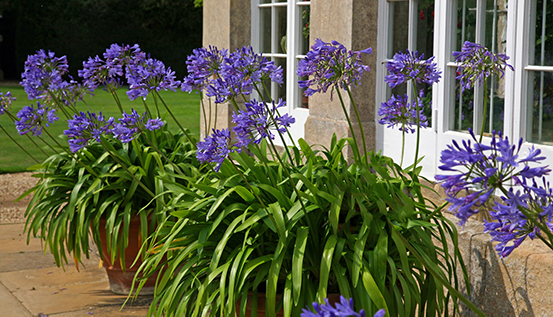Growing Agapanthus
Agapanthus (African Lily or Lily of the Nile) are glorious, sun-loving plants which produce large, spherical flower-heads which brighten up any border, pot or container. Typically planted in late-March through to early-April, they tend to flower from mid-summer through to early-autumn bringing much needed colour into the changing season.
Whilst agapanthus are easy to grow, getting them to flower is slightly trickier, but when they do, they look stunning.
Choosing the right plant. There are two types of Agapanthus - deciduous and evergreen - and when selecting the right plant for your garden, there are a few things to consider.
Deciduous or evergreen? Deciduous varieties such as the ‘Arctic Star’, ‘Ballerina’ or ‘Midnight Dream’ are hardy plants, ideal for borders. They do tend to lose some of their leaves during the cooler weather, but these will come back strong in spring with new growth.
Evergreen varieties are more sensitive and less hardy so will need protection throughout the winter. There are plenty of evergreen varieties to choose from including ‘Hoyland Chelsea Blue’ and ‘Twister’.
Size. Agapanthus vary in height. Some are quite small (around 20-60cm), whilst others can grow as tall as 5ft.
Which colour? Traditionally agapanthus are an inky blue, but they are available in shades of blue, purple, lilac and white. With a softly rounded, trumpet-like head, agapanthus are a popular choice amongst gardeners.
 How to plant
How to plant
Agapanthus should be planted in well-drained soil. If your garden has claggy soil with a lot of clay, add Vitax Claybreaker to help improve drainage, or alternatively plant in pots with a good Multipurpose compost.
Ideally agapanthus should be planted close to a wall for shelter against the wind and in full sun. Avoid planting in shade as it will limit flowering. The key to agapanthus flowering is where it is planted. If your agapanthus produces little to no flowers, consider moving it to a sunnier position.
Agapanthus also grow well when their roots are restricted, so ideal for pots. If planting into a border, plant in the spring or if bought in summer, plant straight into the ground. To give the roots an added boost, add Q4 Rootmore to the bottom of the planting hole so roots are in close contact. This will stimulate root growth and improve the plants nutrition.
Q4 Rootmore can also be added to pots too, to encourage growth.
Caring for your agapanthus
Agapanthus are thirsty plants which require regular watering, especially in the first year of growing. However, regular watering will wash essential nutrients away, so use a good liquid feed such as Q4 Liquid All Purpose Plant Feed or Vitax Organic All Purpose which can be used on a regular basis, especially for pot-based agapanthus.
Once blooms have started to fade, deadhead to encourage more growth.
To overwinter agapanthus, all potted plants should be wrapped in horticultural fleece. Deciduous varieties can moved to a sheltered space which still catches the sun, whereas evergreen varieties should be moved into a frost-free greenhouse or conservatory until the spring.
If your agapanthus is in a border, apply a deep layer of mulch around the plants and remove in spring when growth starts.
Your login details have been used by another user or machine. Login details can only be used once at any one time so you have therefore automatically been logged out. Please contact your sites administrator if you believe this other user or machine has unauthorised access.












